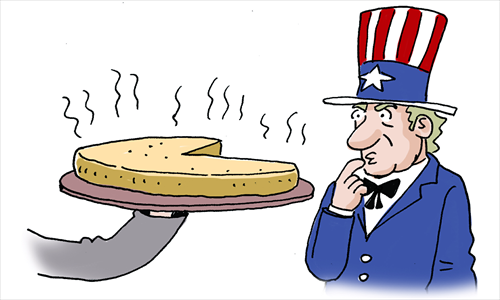HOME >> OP-ED
In US backyard, Chinese company builds a win-win project
By Ding Gang Source:Global Times Published: 2015-7-16 0:38:01
Win-win hospital plan in US backyard

Illustration: Liu Rui/GT
Zhang Qing, 47-year-old, managing director of the Shanghai Construction Group (SCG) (Caribbean) Ltd, drew a circle on the map of the Caribbean and Central America. The starting point of the circle was the Republic of Trinidad and Tobago, where he was based. Half of the circle connected some island countries in the Caribbean area, then went through Miami, extended to Mexico, Costa Rica, Columbia and returned to the Republic of Trinidad and Tobago.
Zhang has been working here for 20 years, 18,000 kilometers away from China. Perhaps only people who understand this place so well like him dare to draw such a circle in the backyard of the US.
During my three-hour talks with him, I heard about his development plans within the circle several times. He hopes the projects his company has done and is going to do can become a development platform for China's financial sector and Chinese enterprises. Miami is their proposed logistic center.
Zhang's vision is not unachievable or empty talk, because he deeply knows that China's development can connect up smoothly with that in the Caribbean and Central America. Such connection will also provide unprecedented opportunities for the US.
The Couva Children's Hospital and Multi-Training Facility, which the SCG helped build, is a convincing example. When I walked into this hospital, built to international standards, I saw a lot of US-made equipment. There were hospital beds from Hill-Rom, a leading US provider of medical technologies, shadowless lamps of German company Maquet, and anesthesia apparatus and electrocardiograph machine with US Mindray brand but made in China.
Zhang said although the SCG received the contract for the hospital project, the design was made by US companies. The equipment was purchased under the requirement of the Trinidad and Tobago government with loans provided by the Chinese government. The key equipment was all made in the US, showing the leading role of the US in medical care facilities and US influence in the region.
When I visited the hospital that will be put into operations soon, I kept thinking about China-US cooperation in Asia. In September, heads of state from both countries will meet in Washington. They do not have time to discuss the development of Chinese enterprises in the Caribbean area, as they have more important agendas to discuss.
But I still hope US President Barack Obama can spare some time to think about projects like the Couva hospital and see how Chinese companies create opportunities for Americans in their backyard.
As globalization deepens, as long as one party provides development opportunities to another party, more parties will be benefited, which in turn benefits the first party. Zhang and his colleagues may not fully understand US global strategy, but they are fully aware of this principle.
If the Obama administration is willing to push US companies to take part in development projects in Asia in a similar approach, more positive results that benefit Asia's development will be generated.
Even if it cannot make it at the current stage, it can join China's "One Belt, One Road" program. It can share the benefits and at the same time create benefits for others.
Now it is political factors rather than economic ones that hinder the US to make such a decision.
Washington's attitude toward the Asian Infrastructure Investment Bank is likely to make it miss a rare development opportunity.
Asia needs the US, just like the Couva hospital needs US-made hospital beds. But this cannot be achieved by simply selling naval vessels.
The author is a senior editor with People's Daily. He is now stationed in Brazil. dinggang@globaltimes.com.cn. Follow him on Twitter at @dinggangchina
Newspaper headline: Win-win hospital plan in US backyard
Posted in: Columnists, Viewpoint